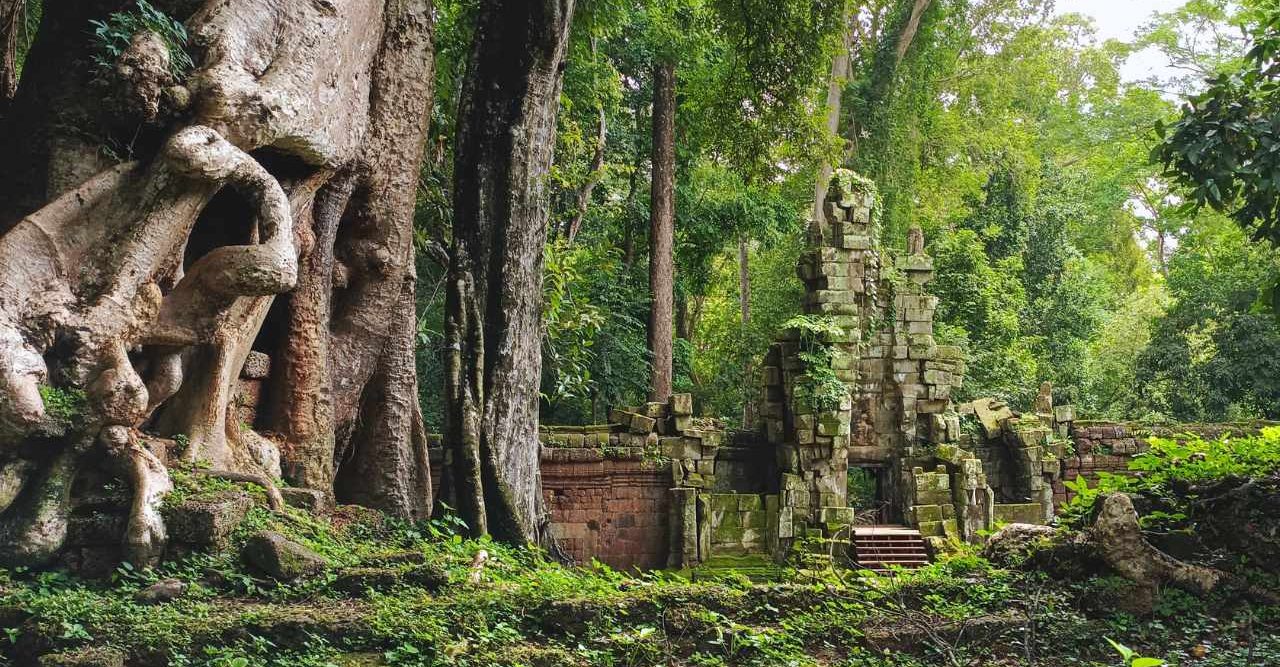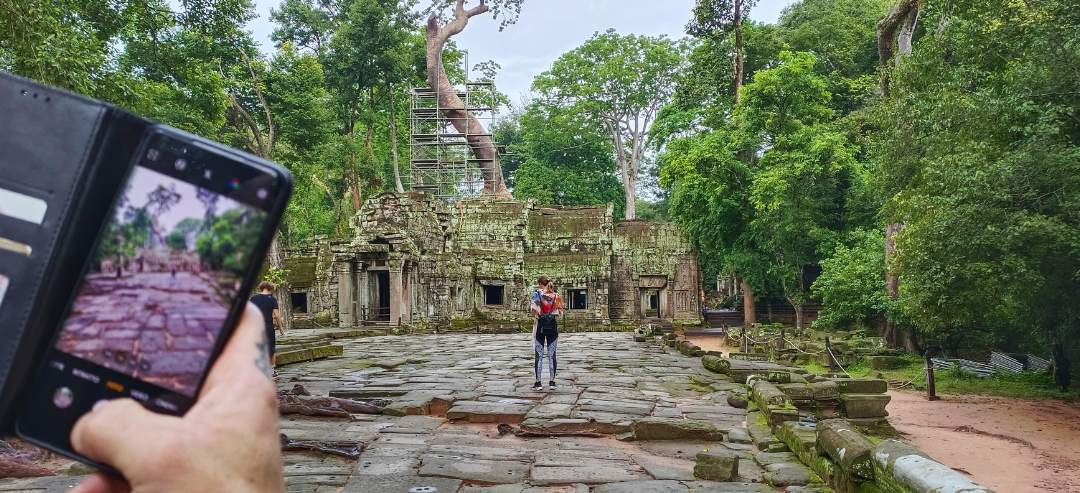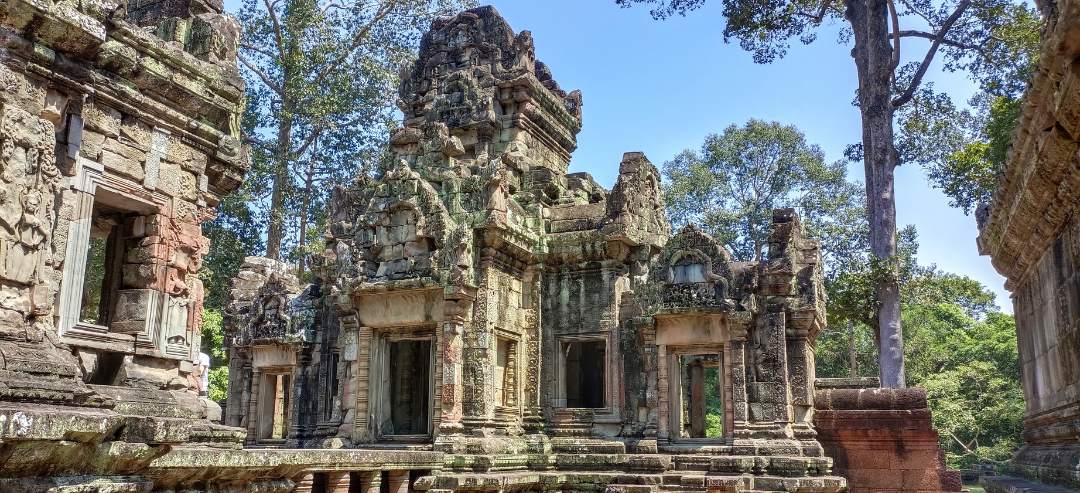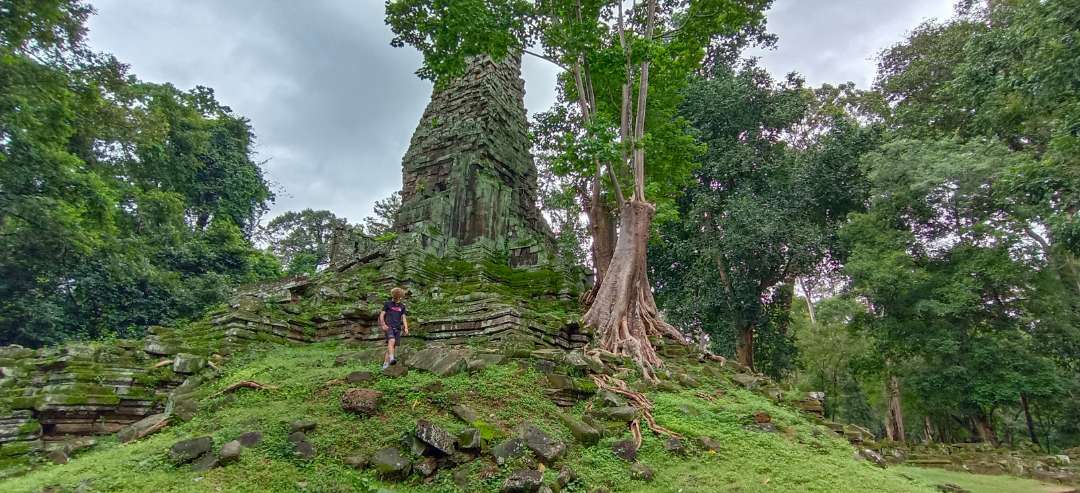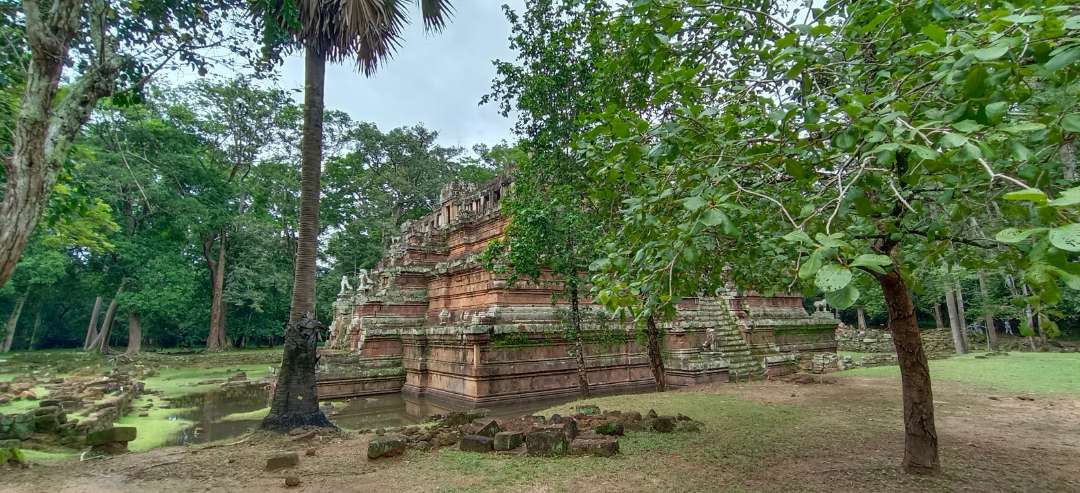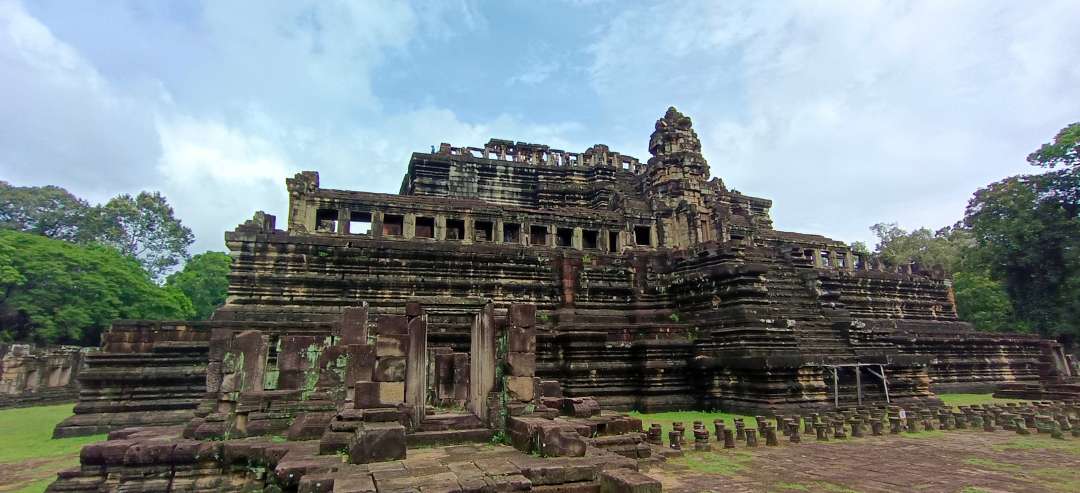Your top choice for Best Angkor early bird tour itinerary – Discover Angkor’s Ancient Glory right after Dawn’s Early Light
Are you looking to experience the magnificent temples of Angkor Wat without the crowds? Then an early bird tour is perfect for you! Waking up before dawn may sound difficult, but it is absolutely worth it to have the chance to watch the sunrise over Angkor Wat and explore the ancient temples in peace.
In this post, I will share my top recommended Angkor early bird tour itinerary to help you maximize your time and make the most of your visit. The keyword “Best Angkor early bird tour” appears 15 times throughout this post to optimize it for search engines.
Here are just a few of the highlights and advantages of booking an Angkor early bird tour:
- Watch the magical sunrise over Angkor Wat in peace and tranquility
- Capture iconic temples like Bayon and Ta Prohm bathed in dawn’s glow
- Beat the crowds to explore ruins undisturbed
- Enjoy cool morning temperatures before the midday heat
- Marvel at intricate bas reliefs and carvings revealed in the soft light
- Soak up the mystical atmosphere without hordes of tourists
- Get insider tips from an expert local guide
- Flexible itinerary customization to fit your interests
Let’s get started!
Ta Prohm Temple at Opening time
The first stop on our Angkor early bird tour Best Angkor early bird tour is the iconic Ta Prohm temple. Arriving here just as the doors open at 5:00 AM allows you to appreciate the eerie beauty of this temple overgrown with towering jungle trees before the crowds arrive.
Is Ta Prohm Temple’s allure worth experiencing live and in person?
Absolutely! Photos cannot capture the true magic of wandering slowly through Ta Prohm’s crumbling halls entwined with mammoth tree roots. Hearing only rustling leaves and birdsong in the early hours, you feel transported back centuries to the temple’s glory days. No matter how iconic the photos, being there as the sun rises over the ruins is an experience like no other.
What sets this Temple apart, offering an extraordinary and unmatched experience?
Ta Prohm is unique in the sheer monumentality of how nature has reclaimed the manmade structures over time. The giant silk-cotton and strangler fig tree trunks snaking through the rocks create an atmosphere found nowhere else at Angkor. The partnership between the ancient temple walls and the enveloping jungle roots makes Ta Prohm an extraordinary place to contemplate the passage of human empires and nature’s endurance.
Unraveling the mystique: What fascinating stories lie behind the history of this remarkable Temple?
Ta Prohm has a rich history stretching back to the rule of Jayavarman VII in the 12th century, dedicated to his mother. After the fall of Angkor, Ta Prohm was forgotten and left largely untouched until French archaeologists “discovered” it buried deep in the Cambodian jungle in the 1800s. This explains the temple’s ruined yet romantic aura, like a relic of an ancient civilization lost to time that you are privileged to stumble upon.
Chau Say Tevoda Temple
After soaking in Ta Prohm’s ambience, we’ll head across the way to the adjacent Chau Say Tevoda temple, dedicated to the Hindu deity Shiva. As the rising sun gradually illuminates the sanctuary towers, take time to appreciate the symmetrical layout and remarkable bas reliefs.
Is Chau Say Tevoda Temple’s allure worth experiencing live and in person?
There is no substitute for seeing the intricacy of Chau Say Tevoda’s carvings up close in the quiet dawn hours. Photos struggle to capture delicate details like lingering smiles on apsara dancers’ faces or sinuous many-headed nagas snakes carved to protect doorways. Wandering the halls, you gain insight into the religious life of Angkor’s priests honoring the gods through sensuous stone artworks.
What sets Ta Prohm Temple apart, offering an extraordinary and unmatched experience?
Chau Say Tevoda stands out for its balance, symmetry, and remarkably preserved carvings. The temple transitions beautifully from rectangular outer galleries to cruciform inner sanctuaries centered on towers to honor Shiva. Getting to admire this harmonious layout mostly undisturbed in the early morning lets you appreciate why Chau Say Tevoda was considered an architectural masterpiece in its day.
What fascinating stories lie behind the history of this remarkable Temple?
Chau Say Tevoda was just one temple part of a sprawling complex built under King Suryavarman II’s rule in the 12th century. After invading Champa, the Khmer Empire turned toward more Hindu worship, reflected in temples like Chau Say Tevoda exalting Shiva. Studying the battle scenes and mythological depictions carved into the walls offers insight into how Angkor’s king harnessed religion to expand and celebrate his earthly power.
Jump to Chau Say Tevoda Temple
Extend Your Exploration into a Second Day
If one day touring the Angkor temples leaves you longing for more, I highly recommend extending your stay to join our Private Angkor Wat Special Tour. This full day excursion with an expert local guide takes you to iconic sites like Angkor Wat and Bayon, as well as hidden gems like Banteay Kdei, Pre Rup, and Banteay Samre.
Highlights of this flexible private tour include:
- Marveling at the unique architectural style of each temple from different eras of the Khmer Empire
- Avoiding crowds to explore complex ruins undisturbed
- Watching a breathtaking sunset over the Kulen Mountains from Phnom Bok temple
- Discovering intricate carvings and bas reliefs up close
- Comfortable air-conditioned transportation between temple sites
With ample time to explore at your own pace, your knowledgeable guide will share insider perspectives to bring Angkor’s history and mystical aura to life. This is an unforgettable way to extend your stay and appreciate the expansive grandeur of the Angkor complex beyond a single early bird tour.
Angkor Thom Victory Gate
Leaving Chau Say Tevoda, we’ll pass through the towering Victory Gate, part of the walls surrounding Angkor Thom. Can’t miss photography opportunities here! The gate’s towers and bridges make a striking silhouette against the morning sky. Pausing to snap some photos through the gate towards the Bayon temple is a must.
What sets this Temple apart, offering an extraordinary and unmatched experience?
Victory Gate stands out for its sheer scale and dramatic silhouette. The sky will just be growing light as we pause for photos, creating moody shots of the towers and bridges contrasted against the dawn sky. Equally impressive is the view through the gate itself towards Bayon temple in the distance. The framed perspective is unique to beholding Victory Gate’s grandeur in person.
Unraveling the mystique: What fascinating stories lie behind the history of this remarkable Temple?
Victory Gate was one of several enormous gopura gates built around the walls of Angkor Thom by Jayavarman VII. Its name originates from a legend that Indra descended through this portal riding an elephant to assist Jayavarman VII in battle against invaders from Champa. The towering gate reflects the king’s military successes and belief in the Hindu gods’ blessings over his empire.
Prasat Preah Palilay Temple
After soaking in Angkor Thom’s grandeur, we’ll pop over to the charming 12th century temple Prasat Preah Palilay. This petite temple sees far fewer visitors but contains exquisite carvings and bas reliefs like its more famous neighbors.
Is this Temple’s allure worth experiencing live and in person?
Wandering through Prasat Preah Palilay’s intimate halls and corridors, it becomes clear no camera could capture the delicate details still visible. Getting to examine the lingering smiles and sinuous bodies of apsara carvings up close feels like a private glimpse into the architects’ craftsmanship and reverence for their gods. Their devotion comes to life most when you can reach out and trace each intricate flourish yourself.
What sets this Temple apart, offering an extraordinary and unmatched experience?
Unlike more imposing complexes, Prasat Preah Palilay’s smaller scale allows you to see carvings and layout features that would otherwise easily be missed. The relative lack of visitors this early provides time to wander slowly and appreciate small moments of artistry, like an apsara’s gently fluttering sash or a floral motif adorning a column. Its size makes Prasat Preah Palilay feel more personal and meditative.
Prasat Preah Palilay: What fascinating stories lie behind the history of this remarkable Temple?
Built under Jayavarman VII’s reign, Prasat Preah Palilay was dedicated to his mother, adding poignancy. The recurring motif of female divinities like apsara reflect the temple’s purpose. Despite its petite size, no effort was spared on lavish ornamentation, suggesting royal patronage. Prasat Preah Palilay stands as a testament to familial love and the enduring power of art.
Phimeanakas Temple
Around 7:00 AM we’ll arrive at Phimeanakas, just in time to start exploring before the crowds roll in. Phimeanakas is believed to have once been an opulent royal palace with a golden tower, and it remains an impressive sight to behold. Climbing up the steps to the top terrace as the morning mist lifts provides panoramic views over Angkor Wat in the distance. Don’t miss the chance to take in this vista on your early bird tour!
Is Phimeanakas Temple’s allure worth experiencing live and in person?
Ascending Phimeanakas’ stairs as the sun rises, seeing the jungle landscape unroll before you mile by mile, you feel a rush no photo can match. Led by an expert guide, your appreciation is heightened realizing this was once the seat of god-kings who ruled over all below. The rising sun emphasizes the empire’s scale in a way only being there in person allows.
What sets this Temple apart, offering an extraordinary and unmatched experience?
Unlike most Angkor ruins, Phimeanakas offers the rare chance to climb towards heavenly views from the pinnacles meant for royals communing with gods. Reaching the top terrace just as mist unveils the horizon showcases the site’s strategic location and rich history as a palace. From this perspective, you can vividly imagine the political power wielded here over Angkor.
Phimeanakas Temple: What fascinating stories lie behind the history of this remarkable Temple?
Phimeanakas has long sparked supernatural legends, including that it was inhabited by a serpent spirit with nine heads. According to myth, this being would appear as a woman to kings at night, and they ruled wisely as long as they slept with her in the tower. This lore hints at why Phimeanakas was so integral to Angkor’s kingship rituals.
Baphuon Temple
After a busy morning exploring Angkor’s wonders, we’ll take a break for breakfast and refreshments before hitting our next iconic site. Reenergized, we’ll visit the Baphuon, a striking temple mountain built in 15th century that has suffered severe damage over the centuries.
Though currently under ongoing restoration, the temple’s imposing ruined bulk still dominates the landscape. Visitors must carefully climb a steep wooden staircase to reach the top. The climb is precarious but presents you with a bird’s eye view looking out over Angkor Thom.
Down below, you can also get up close to behold relics that survived relatively intact, like the giant reclining Buddha stretching along one side of the temple base. Marveling at the sheer scale of construction, you can sense the devotion poured into each titanic sandstone brick.
Is this Temple’s allure worth experiencing live and in person?
Scrambling up Baphuon’s steep staircase, you feel a sense of adventure no static photo can replicate. Reaching the top leaves you winded, making Angkor’s enormity starkly clear. Back down below, you grasp Baphuon’s ambitious engineering seeing the towering Buddha up close. No picture captures the dizzying size you perceive climbing temple mountains like Baphuon.
What sets this Temple apart, offering an extraordinary and unmatched experience?
Baphuon’s monumental size and hill-like design stand out as you hike up dizzying levels, humbled by each step. But the real treasure is to behold relics like the giant reclining Buddha, remarkably preserved despite Baphuon’s otherwise ruined state. This juxtaposition accentuates why seeing its remnants in action is so moving.
Baphuon Temple: What fascinating stories lie behind the history of this remarkable Temple?
Baphuon has been shrouded in tragedy, including the collapse of its central tower in 1566 after being struck by lightning. Painstaking efforts to reconstruct Baphuon reveal how fiercely Cambodians seek to reclaim heritage lost to war and environmental damage. Visiting Baphuon allows you to witness this resurrection firsthand.
Bayon Temple
Our final stop is none other than the centerpiece of Angkor Thom, the renowned Bayon temple. Its most distinctive feature is the multitude of giant carved faces adorning the towers, representing the all-seeing eyes of the Bodhisattva Avalokiteshvara gazing out over the kingdom. By late morning when we arrive, the sun will be high enough to illuminate the faces for optimal viewing and photography.
Even late morning, we’ll reach Bayon before the largest crowds start packing in. That leaves plenty of time to thoughtfully take in the detailed bas reliefs adorning the lower galleries. These depict epic historical events like famous Angkorian battles and coronations, plus intimate glimpses of daily life. I always say you could stare at these storytelling carvings for hours and continually find new meaning.
Is this Temple’s allure worth experiencing live and in person?
There is no describing the transcendent feeling of standing before the Bayon’s serene towering faces as they stare out through the centuries. Their scale and artistry convey majesty beyond what photos can capture. Equally moving is examining the bas reliefs up close, appreciating the craftsmanship required to carve such lively historical scenes and figures by hand.
What sets this Temple apart, offering an extraordinary and unmatched experience?
The Bayon is unique in bringing the reign of Jayavarman VII to life through its carved imagery. Its face towers symbolize divine kingship, the galleries depict expansive battles and rituals, and everyday details reveal insights into how locals lived and worked. This rich storytelling makes Bayon the best temple for imagining Angkor’s medieval heyday.
The mystery exposed: What fascinating stories lie behind the history of this remarkable Temple?
The Bayon represents the pinnacle of Jayavarman VII’s monumental building campaign centering the Khmer Empire on Angkor. Its carved faces likely fuse Buddhism and Hinduism, symbolizing the divine leadership ushering in a new era of prosperity after periods of strife. The Bayon stands as the heart of this powerful historical legacy.
This table summarizes the main benefits of an early tour itinerary:
| Benefit | Description |
|---|---|
| Ideal photography conditions | Capture stunning postcard-worthy shots of the temples at sunrise and in the golden hours |
| Peaceful exploration | Wander through majestic ruins quietly and mindfully before the masses arrive |
| Pleasant weather | Avoid intense midday heat and explore in comfort as temperatures gradually rise |
| Expert guidance | Learn insider info and stories about each temple from knowledgeable local guides |
| Flexible scheduling | Customize and optimize your itinerary to see your must-see priorities |
Conclusion – Reflecting on the Best Angkor Early Bird Tour
As you can see, an early morning tour through Angkor offers a truly magical experience. Waking up while the stars are still out is undoubtedly challenging, but utterly worthwhile. The chance to watch the sunrise over Angkor Wat then explore Ta Prohm and other ancient temples in the serene dawn hours is a travel memory that will stay with you for a lifetime.
Personally, I’m drawn to the romantic, mystical atmosphere Angkor exudes at daybreak. Walking slowly through the sanctuaries, hearing only birdsong and rustling leaves, it feels almost like you’ve stepped back through the centuries. Imagining the kings, priests, dancers, and artisans that once inhabited these spaces comes naturally when you have the temples to yourself. It’s easy to see why Angkor captured the medieval imagination as a earthly manifestation of the divine.
Beyond the reflective historical connections, the photographic opportunities on an early bird tour are simply unmatched. We arrive at each temple shortly after sunrise or when the light is just right to illuminate the intricate carvings. The soft morning glow creates a magic that accentuates Angkor’s sheer artistic mastery and grandeur. I always advise travelers: arise early and you shall be rewarded!
If you seek a peaceful, inspiring experience and the chance to see Angkor’s wonders in a whole new light, I highly recommend booking your own early bird tour.
Contact us to start planning your custom itinerary today. Here’s to many more magical mornings at Angkor!
